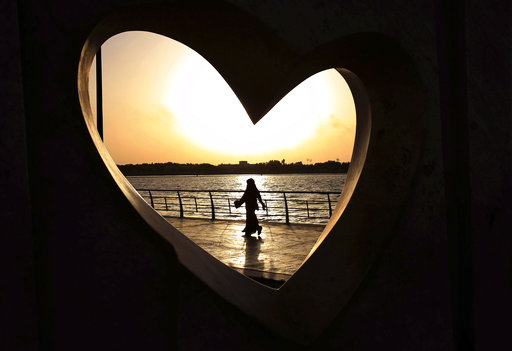
In this May 11, 2014 file photo, a Saudi woman seen through a heart-shaped statue walks along an inlet of the Red Sea in Jiddah, Saudi Arabia. A young Saudi woman has sparked a sensation online by posting a video of herself in a miniskirt and crop top walking around in public, with some Saudis calling for her arrest and others rushing to her defense. The video, first shared on Snapchat, shows her walking around an empty historic fort in Ushaiager, a village north of the capital, Riyadh, in the desert region of Najd, where many of Saudi Arabia’s most conservative tribes and families are from. AP
DUBAI, United Arab Emirates— A Saudi woman has been arrested for defying the kingdom’s strict dress code by walking around in a miniskirt and crop top in a video that sparked public outrage.
The woman, whose name was not given, was detained by police in the capital, Riyadh, for wearing “immodest clothes” that contradicted the country’s conservative Islamic dress code, state media reported Tuesday. Police referred her case to the public prosecutor, according to the official Twitter account of state-run TV channel al-Ekhbariya.
In the video, which has gone viral since first emerging on Snapchat over the weekend, the woman is filmed walking around a historic fort in a miniskirt with no one else around. The short video, shot in a village in the desert region of Najd, where many of Saudi Arabia’s most conservative tribes and families are from, is followed by other shots of her sitting in the desert.
The video sparked a Twitter hashtag that called for her arrest, with many saying she flagrantly disobeyed Saudi rules, which require all women living in the kingdom, including foreigners, to wear long, loose robes known as abayas in public. Most Saudi women also wear a headscarf and veil that covers the face.
Social media is wildly popular in Saudi Arabia as a space to vent frustrations and gauge public opinion. The outcry against the video and the woman’s subsequent arrest reveal how powerful and widespread conservative views are in the kingdom, despite recent moves by Saudi Arabia to modernize and loosen some rules.
The country’s 31-year-old heir to the throne, Crown Prince Mohammed bin Salman, has pushed for greater openings for entertainment in part to appease the youth, who are active on social media and can bypass government censors online. More than half of Saudi Arabia’s population is under 25.
The government announced last week that girls would be allowed for the first time to play sports in public school and have access to physical education classes. The powers of the kingdom’s religious police have also been curtailed, and they are officially no longer allowed to arrest people.
Despite these moves, strict gender segregation rules and other restrictions on women remain in place. Women are not allowed to drive in Saudi Arabia and cannot obtain a passport or travel abroad without a male relative’s permission.
After the woman’s video surfaced, some Saudis expressed alarm, saying that Twitter was being used as a tool to out other citizens.
Saudi writer Waheed al-Ghamdi wrote on Twitter that while the woman violated Saudi laws, her actions did not warrant such an outcry because they did not harm others.
“I am simply questioning the lack of priorities regarding anger and alarm expressed over human rights violations and oppression versus the harmless personal choices of others,” he wrote.
Some of those defending her posted images from President Donald Trump’s visit to Saudi Arabia in May, in which First Lady Melania Trump and his daughter Ivanka, though modestly dressed in higher necklines and longer sleeves, did not cover their heads or wear abayas.
One Twitter user, whose post was shared more than 1,700 times, superimposed an image of Ivanka’s face on the young Saudi woman’s body, writing: “Enough already, the situation has been solved.”
The woman’s image was blurred on Saudi news websites reporting on the case. It is common in Saudi Arabia to see heavily blurred or pixelated images of women’s faces on billboards and storefronts — in stark contrast to the many towering images of senior male royals displayed across the country.